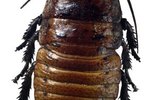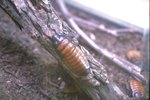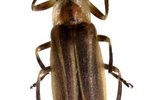
Locusts and cicadas, particularly periodical cicadas, are often confused. However, the two are quite different. Locusts are a type of grasshopper, while cicadas are actually cousins of crickets. The confusion between the two insects has been plaguing North America since the first colonists encountered periodical cicadas. Periodical cicadas which fill the sky every 13 or 17 years, also are different from annual cicadas, which come out of every summer.
Cicadas
All cicadas are members of the Homoptera order of insects. Instead of eating plants, their mouths are designed to suck the juices from the plant for sustenance. Their bodies are typically stout, and their eyes are large, even for their broad heads. Their wings are also easily identifiable because the membranes running through them are clear. Periodical cicadas are typically black or darker colored than their annual cicada relatives.
Periodical Cicadas
As the name implies, these cicadas emerge only at certain times. These cicadas mature underground at depths of up to 2 feet. Different species of periodical cicadas emerge at different intervals. In Missouri, for example, periodical cicadas emerge every 13 and 17 years. Whatever the time frame, the adults emerge from the ground on schedule, usually in May and June. Annual cicadas, on the other hand, emerge from the ground every year in the latter part of summer. Although the large number of periodical cicadas may seem threatening, the risk of damage to plants and trees is small. Most damage occurs when too many cicada eggs are laid on branches, which can cause problems for younger trees. Periodical cicadas are only found in North America.
Locusts

Found all over the world, locusts are a type of grasshopper. Except for their short-horned appearance, locusts and grasshoppers look quite similar. Unlike grasshoppers, however, locusts have developed a dangerous swarming behavior that can be devastating to crops, which the locusts eat, and to the people who rely on those crops for food. Swarms of desert locusts can pack up to 80 million insects into half of a square mile and the entire swarm can stretch for more than 400 square miles. A 2009 study conducted at Cambridge University found that this swarming behavior known as the gregarious phase is stimulated by a collective desperation for food among the insects.
Cause of Confusion
According to the College of Agricultural Science at Pennsylvania State University, the confusion between periodic cicadas and locusts can be traced back to the early colonists. Because periodical cicadas are only found in North America, the colonists did not know how to classify the insects. Their religious background, however, made them knowledgeable about the plagues of locusts discussed in the Bible. Therefore, the colonists assumed these large clouds of insects emerging from the ground periodically were swarms of destructive locusts -- not clouds of less harmful cicadas.
References
Photo Credits
-
Hemera Technologies/PhotoObjects.net/Getty Images
Writer Bio
Amy Jorgensen has ghostwritten more than 100 articles and books on raising and training animals. She is also an amateur dog trainer. She has also written more than 200 blog posts, articles, and ebooks on wedding and party planning on behalf of professionals in the field.




